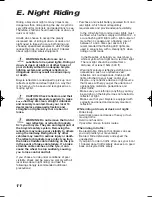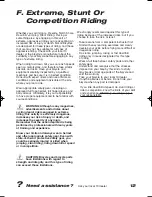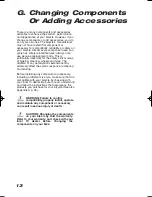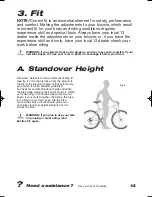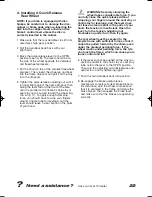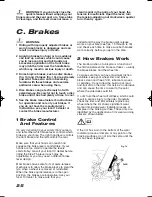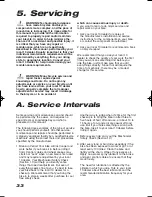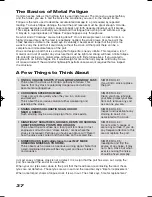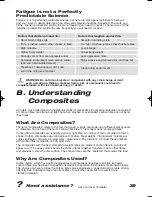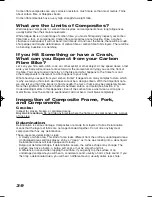
C. Brakes
WARNING: If you can fully close the
quick release without wrapping your
fingers around the seat post or a frame tube
for leverage, and the lever does not leave a
clear imprint in the palm of your hand, the
tension is insufficient. Open the lever; turn
the tension-adjusting nut clockwise a quarter
turn; then try again.
WARNING:
1 Riding with improperly adjusted brakes or
worn brake blocks is dangerous and can
result in serious injury or death.
2 Applying brakes too hard or too suddenly
can lock up a wheel, which could cause
you to lose control and fall. Sudden or
excessive application of the front brake
may pitch the rider over the handlebars,
which may result in serious injury or death.
3 Some bicycle brakes, such as disc brakes
(fig. 14) and V brakes (fig. 15), are extremely
powerful. Take extra care in becoming
familiar with these brakes and exercise
particular care when using them.
4 Disc brakes can get extremely hot with
extended use. Be careful not to touch a disc
brake until it has had plenty of time to cool.
5 See the brake manufacturer’s instructions
for operation and care of your brakes. If
you do not have the manufacturer’s
instructions, see your local 13 dealer or
contact the brake manufacturer.
1 Brake Control
And Features
It’s very important to your safety that you learn
and remember which brake lever controls which
brake on your bike. The right hand lever controls
the front brake and the left controls the rear.
Make sure that your hands can reach and
squeeze the brake levers comfortably. If your
hands are too small to operate the levers
comfortably, consult your
local 13 dealer
before
riding the bike. The lever reach may be
adjustable; or you may need a different brake
lever design.
Most brakes have some form of quick-release
mechanism to allow the brake blocks to clear the
tyre when a wheel is removed or reinstalled.
When the brake quick release is in the open
position, the brakes are inoperative. Ask your
local 13 dealer
to make sure that you
understand the way the brake quick release
works on your bike (see figs. 14 through to 18)
and check each time to make sure both brakes
work correctly before you get on the bike.
2 How Brakes Work
The braking action of a bicycle is a function of
the friction between the brake surfaces – usually
the brake blocks and the wheel rim.
To make sure that you have maximum friction
available, keep your wheel rims and brake
blocks clean and free of dirt, lubricants, waxes
or polishes. Do not allow the build up of road
and trail dirt on the rims; this acts as an abrasive
and can cause the rims to wear to the point
where the sidewalls could fail.
If a rim fails the wheel will collapse, which could
result in serious injury to the rider. Regularly
check the rims and immediately replace any
wheel where the rim shows significant wear.
Some rims include wear indicator grooves or
dimples in the braking surface. These rims are
identified by the application of rim wear warning
stickers, shown below:
If the rim has worn to the bottom of the wear
Indicator groove or dimple, at any point on the
braking surfaces, do not ride the cycle until the
rim has been replaced.
25
Fig. 14
DISC
13
owners manual GENERIC A5 aw
05/05/14
10:25 Page 27

